What is the best way of judging the ability of prospective PhD students? Robert P Crease outlines his thoughts – and asks for your ideas

“You have two square potential wells of the same width,” my Stony Brook colleague Xu Du said to the candidate. “One is infinitely high, the other finite. Which has the higher ground-state energy? Explain the answer as you would to an undergraduate, in two or three minutes and without doing any calculations.” Du then added that as he was an experimentalist, the answer should be intuitive – no formal derivation was needed.
Du and I were in China interviewing students who had applied for admission to Stony Brook’s graduate programmes in physics and in several other disciplines. The admissions committees had found that many of the qualities that they were looking for in candidates – including knowledge, motivation and experience – could be assessed from the students’ records and recommendations. But one important duty of graduate students is to tutor undergraduates and serve as teaching assistants. To do this well, sheer knowledge of physics and a good command of English are insufficient. Gauging the promise of candidates in tutoring was therefore one task that Du and I had in conducting these interviews.
But how do you test the tutoring ability of a student from another culture, especially when we had only 15 minutes in total to talk to each candidate?
Du, who is a condensed-matter physicist, had devised a clever solution. He selected a set of special physics problems, and towards the end of each interview would randomly select one – asking the candidate not to solve it, but to explain how we would find the answer if we were undergraduates. They looked and sounded like ordinary textbook problems. They weren’t quite; they were deceptively challenging. To explain them in two or three minutes involved a little more speed than the typical textbook problem, a little more cleverness in identifying the conceptual issue, and a little more fluidity in couching the explanation.
Well put
Language difficulties sometimes delayed some students’ initial understanding of the problem. Nervousness momentarily paralysed others, until Du coaxed them into relaxing. Some candidates ritually began by writing down Schrödinger’s equation, whereupon Du would interrupt and remind them that the task was not to solve the problem but explain it as they would to an undergraduate or younger sibling, who would not know that method yet. Another incorrect approach was to simply announce the answer without explaining it.
How each candidate went about answering Du’s challenge, we found, seemed a fairly good indicator of their ability as a potential teaching assistant – and even of their style of thinking. Those students with an experimental bent often began by envisioning the extreme case – dropping the finite well to zero, in which case there would be a free wave and no ground state – to articulate the (correct) conclusion that the infinite case had to have the higher energy. More theoretically oriented students would invoke the uncertainty principle to settle the issue without calculation. Even here, many paths were available for brief explanations: the uncertainty principle means that a particle will not tunnel from the infinite well, meaning that it has higher energy; that Δx is smaller in the infinite well; that the wave equation extends beyond the finite well, and so forth. A promising teaching assistant, in short, would produce a principle and use it in a succinct way to convey what shapes the answer.
Another problem was the following. Consider a charged particle moving circularly in a magnetic field. Find the kinetic energy of the particle using classical mechanics plus the quantization of angular momentum (in what amounts to a Bohr-atom-like way). The candidate would then have to explain that finding the answer involves writing down two expressions that equal one another, one for the centripetal (Lorentz) force and the other for the centrifugal (mechanical) force: Qvb = mv2/r. Then you apply the quantization condition 2πr = nh/p. Again, this can be explained succinctly by a principle in many ways: it has to be a standing wave, the wave has to return to its beginning, and so forth.
The critical point
A few Chinese candidates startled us by referring to “plumbum”, “kalium”, “natrium” etc, using the ancient Latin names of elements (lead, potassium and sodium in this case) from which their current symbols are derived. Still, we found that, if we compensated for language difficulties among some students and nervousness among others, the Chinese students exhibited about the same range of abilities in successfully answering the questions as US students. Some, that is, had an extraordinary ability to explain principles and their application clearly and succinctly, while others had difficulty even when their general physics knowledge was outstanding. A good test question, it seems, is equally effective the world over.
The challenge questions that one looks for are those that do not involve calculation but conceptualization, or a general sense of the physics involved. The student must then convey the conceptualization and how it settles the problem swiftly and succinctly at the undergraduate level. These questions therefore test what I like to call “impedance matching”, or the ability to match the “load” of one’s explanation to the environment in which it must be understood. I imagine that there must be many such questions, and I invite you to send me your favourite challenge problems – or other means of evaluation. I shall discuss your responses in a future column.
- What are your best methods for evaluating prospective PhD students? Send your thoughts to Robert P Crease at the address or e-mail below



